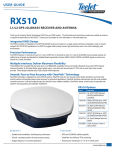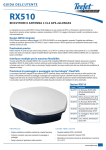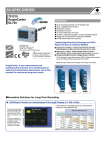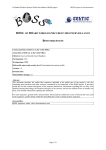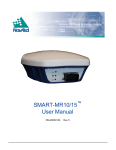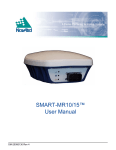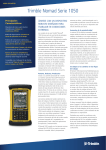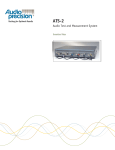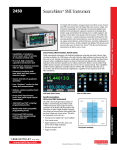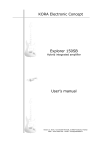Download USER GUIDE
Transcript
U S ER GUI DE RX610 L1/L2 GPS+L1/L2 GLONASS RECEIVER SMART ANTENNA with integrated cellular modem for access to wireless RTK corrections Thank you for choosing TeeJet Technologies’ RX610 as your RTK solution. The information and instructions provided are available to enhance or expand the performance of the RX610. Contact your local dealer for more information or visit www.teejet.com. Integrated GNSS Design The RX610 provides an integrated L1/L2 GPS+GLONASS receiver and antenna in a single compact enclosure. Designed to meet or exceed stringent MIL-STD-810G specifications, the RX610’s rugged metal housing ensures high performance even in the most challenging work environments. Integrated Cellular Modem The RX610 comes equipped with an embedded CDMA (Carrier Division Multiple Access) or GPRS/HSDPA/GSM (General Packet Radio Service / High Speed Downlink Packet Access / Global System for Mobile) radio to allow NTRIP data to be received over a cellular network. The CDMA radio is Verizon Wireless carrier approved and the GPRS/HSDPA/GSM radio is PTCRB and GFC certified to ensure optimal operation. An external cellular connector with optional high efficiency antenna provides robust connections even in poor coverage areas. Precision Performance The RX610 features 14 channels for each of L1 and L2 GPS and 12 channels for each of L1 and L2 GLONASS code and phase tracking. An additional two channels are dedicated for Satellite-Based Augmentation System (WAAS, EGNOS and MSAS) signals as well as one channel for L-band (OmniSTAR®). Multiple Interfaces Deliver Maximum Flexibility Two NMEA 0183 compatible RS-232 serial ports, one NMEA2000 compatible CAN port and built-in Bluetooth ensure the RX610 delivers maximum flexibility. An Emulated Radar ground speed output, a one pulse per second output (1 PPS) and an event mark input are also provided. Three daylight readable status LEDs simplify infield diagnoses. Smooth, Pass-to-Pass Accuracy with ClearPath® Technology ClearPath technology is integrated into every RX610 antenna. ClearPath uses the very accurate carrier phase calculations to provide ultra smooth positions and excellent pass-to-pass accuracy for agricultural applications. ClearPath functions autonomously and with most available corrections services. It will also bridge through short periods of poor satellite availability. ClearPath’s steady, smooth output is especially well suited for manual guidance and autosteer installations. CDMA Whip Antenna shown BENEFITS F E AT U R E S • Scalable dual-constellation, dual-frequency performance • GPS and GLONASS satellite capability • Smooth, consistent positions for pass-to-pass accuracy • ClearPath® and AdVance® RTK positioning • Rugged design for on-machine applications • Robust power handling for 12 V to 24 V vehicle power • OmniSTAR® compatibility • Integrated cellular modem for access to wireless RTK Network www.teejet.com U SER G UI DE CORS NETWORK RTK / NTRIP CORRECTIONS VIA CELLULAR NETWORK Setup and usage of the NTRIP feature on TeeJet RX610 systems when paired with TeeJet Matrix PRO. Description DEFINITIONS • NTRIP allows the RX610 receiver/smart antenna to receive RTK corrections from local CORS or RTK networks, where available. CORS (Continuously Operating Reference Station)/ Network RTK • The cellular modem built into the RX610 is used to access the Internet, from which the RTK correction data is sourced. A series of base stations spread across a given geographic region (such as an entire state/county) that are networked via a centralized computer and which broadcast RTK correction data over the Internet. CORS networks may be publicly or privately owned/operated and may offer a free signal or require an annual subscription fee. By accessing a CORS network via a cellular connection, the end-user eliminates the need to own a base station. Benefits Using NTRIP allows the RX610 to generate RTK precision GPS coordinates without using a local base station. Limitations NTRIP can only be used when a good connection to the Internet is present. Internet connections supported through the internal modem built into the RX610 are CDMA (Verizon) or GPRS/HSDPA/GSM (AT&T, T-Mobile). A Data Plan through a local cellular carrier must be purchased for the RX610 in order for the system to operate on CORS networks. NTRIP (Networked Transportation of RTCM via Internet Protocol) An internet based application that makes the RTCM Correction data from the CORS stations available to anyone with an internet connection and the appropriate log on credentials to the NTRIP server. Typically uses a cellular link to connect the rover to the internet and the NTRIP server. Required Items • In order to use NTRIP, it is necessary to be within the bounds of the network being used. Only NTRIP streams providing CMR, CMR+, or RTCM 3 format corrections are supported. GLONASS is only supported with RTCM 3 format when available through RTK provider. • Data Plan obtained from cellular provider for integrated modem in RX610. 5GB per month rate plans are recommended for network RTK. Network RTK COMMON SATELLITE COMMON SATELLITE NETWORK SERVER INTERNET REFERENCE STATION TEEJET RX610 REFERENCE STATION REFERENCE STATION REFERENCE STATION 2 98-01411 R0 US MASTER STATION T EE JE T T EC H N OLO G IE S GETTING STARTED This guide provides the information you need to set up and begin using your new RX610. 0.402 in (10.20 mm) Opening 9.2 in 234 mm 11.125 in 280 mm 3.5 in 89 mm 12 in 300 mm 9.2 in 234 mm 3.25 in 83 mm 2.25 in 57 mm CDMA Whip Antenna 12 in 300 mm 3.25 in 83 mm GPRS/HSDPA/GSM Antenna RX610 LEDs 8.217 in (208.70 mm) LEDs on the front of the RX610 provide basic receiver status information. The operation of the LEDs on the RX610 is summarized in the following table: Red Yellow Green Condition Off Off Off Power is not available or there has been a hardware failure. On Off Off Power available but no satellites are being tracked. No cellular network connection.* On Flashing Off Tracking at least one satellite but not a valid position. No cellular network connection. On On Off Position valid in basic autonomous mode. No cellular network connection. On On Flashing SBAS tracking, but not enough data for enhanced solution. Connected to cellular network but not receiving RTK corrections. On On On On R2.01 in (5.10 mm) TYP. 3.937 in (100.00 mm) Position valid in an enhanced accuracy mode** (WAAS/EGNOS/MSAS/DGPS, OmniSTAR VBS/ XP/HP, or RTK). Connected to cellular network and receiving RTK corrections. Flashing Flashing Fixed position with bad integrity. Connected to cellular network but not receiving RTK corrections. * If the RX610 NTRIP client is not active, LED operation will not reflect the status of the cellular network. ** When acting as a reference receiver, all lights on solid indicates a good fixed position. 0.492 in (12.5 mm) TYP. 1.969 in (50.00 mm) www.teejet.com 3 U SER G UI DE MOUNTING PLATE INSTALLATION INSTRUCTIONS Intermediate Mounting Plate Template A template for the intermediate mounting plate (included in the optional Quick Release Mounting kit part number 90-02744) has been drawn in the background of this user guide (pages 3 and 6). Figure 1-1: Intermediate Mounting Plate • Red lines indicate holes where attachment will occur. • Green lines indicate the outline of the mount and other holes for attaching the release plate. The universal mounting plate can be used in several configurations: • Stand-alone plate that is hard-mounted onto the implement • Hard-mounted onto an intermediate plate • As part of the quick-release kit The mounting holes in the RX610 will align with the dimple locations in the universal mounting plate. You can use Metric or Imperial Countersunk head bolts as follows: Figure 1-2: Complete Mounting Kit Quick Release Latch Universal Mounting Plate • Metric.............. Quantity 4 M6x 1.0mm bolts no longer than 15mm • Imperial........... Quantity 4 1/4-20 bolts no longer than 1/2" Mounting Considerations • Choose a location that has a clear view of the sky so that each satellite above the horizon can be tracked without obstruction. Intermediate Mounting Plate • RX610 cable is typically connected near the Quick Release Latch, usually towards the back of the cab. • The accompanying cellular antenna should be mounted at least 12″ / 30 cm from the RX610 receiver on a metal surface. • When mounting the RX610 Receiver, a space of at least 6″ / 15 cm between the receiver and any bend in the cable is required. Any length shorter than 6″ / 15 cm puts undue stress on the cable and the enclosure for the RX610. • The receiver should not be mounted where water can pool around it. The receiver housing is designed to withstand rain and splashing, but not submersion in liquids for sustained periods of time. • Mount the receiver above all other metal objects to avoid multipath. Satellite signals received by the GPS receiver by a reflection from an object can decrease positioning accuracy. For example, roof racks, large headlight enclosures, etc., can cause multipath that may result in a jump in GPS position. ANTENNA INSTALLATION Mounting Considerations • Be sure to connect the correct antenna to the receiver. • Do not connect a CDMA whip antenna to a GPRS/HSDPA/GSM RX610 receiver. • Do not connect a GPRS/HSDPA/GSM antenna to a CDMA RX610 receiver. • Mount the cellular antenna at least 12″ / 30 cm from the RX610 receiver. • In most installations, the cellular antenna should be mounted on top of the cab as far forward as possible on a metal surface of at least 4″ square. If the mounting surface is not metal, use the included metal plate and Velcro® to create a metal base for the antenna. 4 98-01411 R0 US T EE JE T T EC H N OLO G IE S CABLE CONNECTIONS The following diagram is reflective of a typical RX610 with Matrix Pro and FieldPilot configuration. Due to the variety of possible configurations, this should be used for reference purposes only. Figure 1-3: System Diagram with Matrix Pro and FieldPilot Matrix Pro 570G Matrix Pro 840G Power/DATA 45-05626 RX610 GPS Receiver, RTK RS-232 RS-232 45-05808 Smart Antenna Cable POWER IN Power/CAN/Data Cable (included with FieldPilot and BoomPilot kits) CAN Steering Control Module (SCM) SCM Power I/O 45-07703 DC: xx/xx CAN Valve Output SCM COM 2 GPS In COM 1 POWER IN GPS Power Co nn (+ ecto 12 v) to Remote Engage/Disengage Seat Sensor FieldPilot Interface 78-08072 DC: xx/xx Steering Wheel Sense 45-05381 DC: xx/xx Steering Valve Engage / Disengage 32-04020 DC: xx/xx Power SCM Harness RX610 Options 45-10103 DC: xx/xx Part # Description 90-02791 Kit: RX610 GPS RTK Receiver – CDMA, North America; Cable; Antenna 78-50193 RX610,GPS Receiver – CDMA, North America 78-50196 CDMA Whip Antenna 78-50197 CDMA Whip Antenna Base 90-02792 Kit: RX610 GPS RTK Receiver – GPRS/HSDPA/GSM, North America; Cable; Antenna 90-02793 Kit: RX610 GPS RTK Receiver – GPRS/HSDPA/GSM, Europe; Cable; Antenna 78-50194 RX610 GPS Receiver – GPRS/HSDPA/GSM, North America 78-50195 RX610 GPS Receiver – GPRS/HSDPA/GSM, Europe 78-50198 GPRS/HSDPA/GSM Antenna 78-50199 GPRS/HSDPA/GSM Antenna Base 90-02744 Kit: Quick Release Mount for RX510/RX610 45-05808 Cable – Antenna, Power to Serial w/Pins www.teejet.com 5 U SER G UI DE ACTIVE CELLULAR DATA PLAN CONFIRMATION TeeJet Technologies will provide the RX610 pre-configured with only the cellular data plan to be purchased by the end-user. In order to preconfigure the RX610, the items listed on bulletin 98-01410 (obtained from dealer) were required before contacting TeeJet Technologies to place your order: If these requested items have changed or were provided with a mistake, please contact your local dealer or TeeJet Technologies for further assistance. SIM CARD INSTALLATION SIM Card Installation is for GPRS/HSDPA/GSM units only. A SIM card is not used with the CDMA unit. To install the SIM Card: 1. Remove the SIM cover by loosening the two screws that secure the cover. NOTE: When you are replacing the SIM cover, make sure it is installed straight or you may inadvertently cause the SIM card to eject. 2. Install the SIM following the orientation shown on the SIM cover (notch up and in, as shown). The SIM connector is a push -in/push-out type. If the SIM is correctly installed, its outside edge will be essentially flush with the surrounding enclosure metal surface. NOTE: To remove the SIM push it in slightly and it should then be partially ejected by the SIM holder. The modem will not work if the SIM is in the partially ejected “ready for removal” position. Ensure the SIM door is properly aligned, then secure it in place. WARNING: Secure the SIM cover to the base using a flat-head screwdriver. Screws should be torqued to 4-6 in-lb / 22-34 cm-kg, to ensure the unit does not leak. 6 98-01411 R0 US T EE JE T T EC H N OLO G IE S MATRIX PRO GPS SETTINGS GPS Port Setting on Matrix Pro Working with GPS signals such as OmniSTAR HP/XP or RTK will require the GPS port to be set to External. GPS Port sets port transmission to Internal or External. 1. Press CONFIGURATION side tab 2. Press GPS . 3. Press GPS Port DOWN arrow 4. Select External . . Quality Indicator on Matrix Pro When the RX610 is providing RTK correction, the Quality Indicator on the Matrix Pro should read "4". Figure 1-5: GPS Status from Operation Screens Mark A -13 7.2 km/h to access the list of options. 5. Press RETURN arrow or CONFIGURATION side tab return to the main Configuration screen. to Figure 1-4: GPS Port Mark A -13 Configuration Vehicle Implement AutoSteer Tilt 7.2 km/h GGA Rate: 5 Hz VTG Rate: 5 Hz Num Sats: 10 Lightbar HDOP: 1 GPS PRN: 135 GGA Quality: 4 Video Receiver: 1 Config->GPS GPS Type GPS/DGPS GPS Port External GPS Status Internal Information External Figure 1-6: GPS Status from Setup Screen Config->GPS GPS Type GPS/DGPS GPS Port Internal GPS Status Config->GPS GPS Type GPS Port GPS Status Information GPS Information GGA Rate: 5 Hz GPS/DGPS VTG Rate: 5 Hz Num Sats: 10 HDOP: 1 Internal PRN: 135 GGA Quality: 4 Receiver: 1 Information Version: OK NOTE: If GPS is not available, all entries will be “Invalid” www.teejet.com 7 U S ER G U IDE SPECIFICATIONS Performance Channel Configuration 14 GPS L1, 14 GPS L2 12 GLONASS L1, 12 GLONASS L2 (optional) 2 SBAS 1 L-band Horizontal Position Accuracy (RMS)1 Autonomous (L1).......................................... 1.5 m Autonomous (L1/L2)..................................... 1.2 m SBAS2........................................................... 0.6 m CDGPS......................................................... 0.6 m DGPS........................................................... 0.4 m OmniSTAR VBS........................................... 0.6 m OmniSTAR XP............................................ 0.15 m OmniSTAR HP.............................................. 0.1 m RT-20®3 (optional)......................................... 0.2 m RT-2™3 (optional)................................1 cm+1ppm Measurement Precision GPS GLONASS L1 C/A Code.........................4.0 cm........15.0 cm L1 Carrier Phase..................0.5 mm.........1.5 mm L2 P(Y) Code........................8.0 cm..........8.0 cm L2 Carrier Phase..................1.0 mm.........1.5 mm Maximum Data Rate Measurements...................1Hz, 5Hz, 10Hz, 20Hz4 Position..............................1Hz, 5Hz, 10Hz, 20Hz4 Time to First Fix Cold Start5.......................................................65 s Hot Start6.........................................................35 s Signal Reacquisition L1..................................................... 0.5 s (typical) L2..................................................... 1.0 s (typical) Accuracy Time Accuracy7.................................... 20 ns RMS Velocity Accuracy8...........................0.03 m/s RMS Physical and Electrical Dimensions............................ 9.2″ x 9.2″ x 3.5″ (H) ............................233 mm x 233 mm x 90 mm (H) Weight........................................... 4.63 lbs, 2.1 kg Input Voltage..................................+9 to +36 VDC Power Consumption........................4.5 W (typical) Connector............................. 23-pin Tyco Ampseal Mounting...............1/4 NC and M6 mounting holes Communication Ports 2 RS-232 serial ports................230, 400 BPA max One port configurable to RS-422 1 CAN Bus NMEA 20008 1 Bluetooth 1 PPS Ground speed output Event mark input Environmental Temperature Operating...........-40°F to +149°F, -40°C to +65°C Storage..............-40°F to +185°F, -40°C to +85°C Humidity..............................95% non-condensing Vibration Random......................................... MIL-STD-202G Sinusoidal......................................... ASAE EP455 Shock................................. MIL-STD-810G, 516.6 Immersion......................... MIL-STD-810G, 512.5 Blowing Rain..................... MIL-STD-810G, 506.5 Water Jets.................................. IEC 60529 IPX6 Object Ingress & Immersion...... IEC 60529 IP67 Aggravated Cycle............. MIL-STD-810G, 507.5 Ingress Protection Rating............................ IP67 Compliance Emissions......FCC, CE, Industry Canada, BT SIG Immunity & Safety............................................ CE Vehicular Standards ISO 7637: Compliance ensures product’s ability to operate through vehicular electrical system surges (including inductive load switching transients, crank cycle and load dump) ISO 15003: Compliance ensures product’s ability to withstand vehicular electrical system abnormal conditions (short circuits to battery or ground, overvoltage reverse polarity and abnormal power voltage) Radios Bluetooth................................................BT SIG CDMA.......................................Verizon certified GSM/GPRS/HSDPA.....PTCRB & GCF certified Warranty 1 Year From Date of Purchase Cellular Connectivity CDMA Option Dual-band....................................... 800/1900 MHz 1xRTT data..................................up to 153.6 kbps External antenna connector GSM/GPRS/HSDPA Option Tri-band UMTS/HSDPA......... 850/1900/2100 MHz Quad-band EGSM.......... 850/900/1800/1900 MHz HSDPA.....................................................7.2 Mbps GPRS multi-slot....................................... Class 12 EDGE multi-slot....................................... Class 12 External antenna connector External SIM access Electrical Connection Connector’s Pin-outs 1............................................................... Power + 2................................................................ Power 3.................................................................CAN1 4................................................................CAN1 + 5.................................................................. TXD 2 6..................................................................RXD 2 7.....................................................TXD1/TXD1 +* 8.........................................RTS1/AUXTX/TXD1 -* 9.................................................. Signal Ground 2 10........................................................... Reserved 11............................................................ Reserved 12........................................................... Reserved 13........................................................... Reserved 14.................................................Chassis Ground 15................................................ Signal Ground 1 16.................................................................... MKI 17................................................................... PPS 18..................................................................... ER 19................................................................MODE 20........................................................... Reserved 21........................................................... Reserved 22......................................CTS1/AUXRX/RXD1 -* 23...................................................RXD1/RXD! +* * The RX610 is RS-232/RS-422-selectable through pin 19 1 Typical values. Performance specifications subject to GPS system characteristics, US DOD operational degradation, ionospheric and tropospheric conditions, satellite geometry, baseline length, multipath effects and the presence of intentional or unintentional interference sources. 2 Satellite Based Augmentation Systems (SBAS) include WAAS (North America), EGNOS (Europe) and MSAS (Japan). 3 Expected accuracy after convergence. RT-20 and RT-2 are independent of ClearPath. 4 Contact TeeJet Technologies for 20Hz operation. 5 Typical value. No almanac or ephemerides and no approximate position or time. 6 Typical value. Almanac and recent ephemerides saved and approximate time entered. 7 Relative time accuracy does not include biases due to RF or antenna delay. 8 Export licensing restricts operation to a maximum velocity of 515 meters per second. TeeJet Technologies 1801 Business Park Drive Springfield, Illinois 62703 USA Tel: (217) 747-0235 • Fax: (217) 753-8426 www.teejet.com 98-01411 R0 US English © TeeJet Technologies 2011








